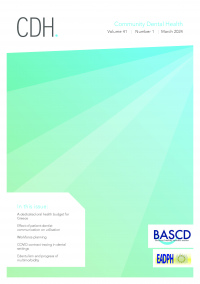March 2019
Low rates of dental attendance by the age of one and inequality between local government administrative areas in England
Abstract
Objective: To describe child dental attendance (DA) by 1 year of age in England and its relationship with area deprivation. Basic research design: Analysis of National Health Service data for the 12 months to June 2017. Deprivation was measured by Index of Multiple Deprivation Rank of Average Score (2015) for upper-tier and unitary local authorities in England (LAs, n=151). DA rates were calculated for children under 1 year (<1yr) and children aged 1 year and under (≤1yr). A Spearman’s test assessed strength of association with deprivation. The Slope Index of Inequality (SII) and Relative Index of Inequality (RII) explored equity. Clinical setting: Upper-tier and unitary LAs in England. Main outcome measure: Attending an NHS primary care dental service. Results: DA rates ranged from 0 to 12.3% (Median:2; IQR:1.4,3.9) in children <1yr and from 3.7 to 37.6% (Median:10; IQR:7.4,17) in children ≤1yr. DA rates decreased as deprivation decreased (Spearman=-0.25, p=0.0019 in children <1yr; Spearman=-0.21, p=0.0104 in children ≤1yr). The SII suggested a 2 percentage point difference in DA rate across the deprivation distribution in children <1yr (SII=-0.02, 95% CI=-0.01,-0.04; p=<0.001); and a 5 point difference in children ≤1yr (SII=-0.05, 95% CI=-0.02,-0.09; p=0.003). The DA rate in the most deprived LA was 2.1 higher than the least deprived LA (RII=2.1, 95% CI=1.4,3.2; p=<0.001) in children <1yr and 1.5 higher (RII=1.5, 95% CI=1.2,2; p=0.004) in children ≤1yr. Conclusions: DA rates were low for all LAs and only partially explained by deprivation. More deprived LAs were, unexpectedly, more likely to report higher DA rates. Keywords: Dental Health Services; England; Dental Attendance; Dentistry; Dental Caries




